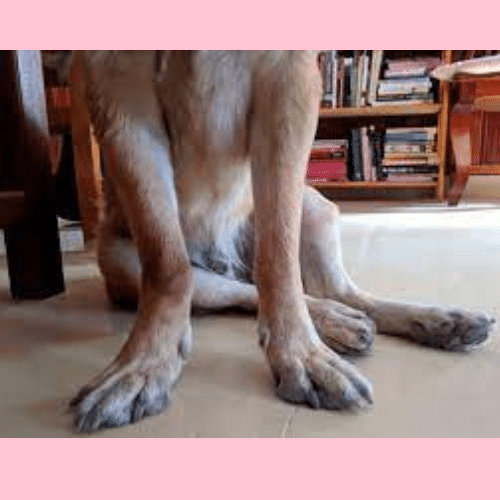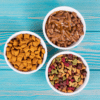Have you observed that when your dog is just standing still, its feet point outwards? They might be suffering from a condition known as East-West feet.
Does this pose a problem for them? If yes, then how do you fix East West feet in dogs?
The most effective treatments for pups with east-west feet are maintaining a balanced diet and ensuring that the dog gets appropriate activity/exercise.

Major Causes of East-West Feet in Dogs
The following are some of the common causes of why pups have east-west feet, as well as some treatment recommendations for the condition.
- Genetics
Since you cannot alter the size of your dog’s bones, treating genetic conditions might be challenging. Even if your dog has feet that face opposite directions, the easiest way to ensure that it stays healthy is to reduce the amount of stress placed on its joints. It can be performed by avoiding activities that are too demanding for the individual and leaping around an excessive amount.
- Weight
Some dogs, especially smaller canines, are more likely to suffer from injuries like east-west feet due to their owner’s weight increase. It is of the utmost importance to maintain dogs’ health by providing them with well-balanced food and giving them frequent exercise. Offering your dog many snacks or foods rich in protein is not a good idea. If your tiny dog is getting heavier, you should increase the amount of activity they get regularly and gradually reduce the amount of food they consume.

- Long Nails
It is crucial to maintain a healthy length for your dog’s nails. If they get too long, it might cause the paw pads on their feet to point in an east-west direction. Your dog’s equilibrium might become off-kilter if its nails are allowed to grow too long. Dogs with sharp claws are more prone to endure the discomfort caused by breaking, chipping, ripping, and splitting their nails. In addition, when they move or rest on their claws, the pressure is placed on the incorrect portions of their feet, which can cause long-term damage. Your dog may begin to walk unusually to alleviate the discomfort, but this might result in more joint damage. It presents a formidable challenge in elderly dogs, whose posture could be subpar.
- Medical Issues
D carpal valgus
The condition is fulfilled by the counterpart of the human wrist in the canine anatomy. A developing deformity known as carpal valgus can occur on the carpus. This illness most commonly affects pups, although it can remain in an adult dog for as long as seven months. This ailment impacts the front limbs and causes the foot to bend inside rather than outward. Several hypotheses suggest this illness results from an imbalance in the growth of the bones and tendons in the front legs. Altering your dog’s nutrition is one strategy you might use to solve this issue. Nevertheless, taking the pup to the veterinarian to get it checked out would be the most prudent thing to do in this situation.
Elbow Dysplasia
The underlying ailment might be something like canine elbow dysplasia (CED), which is a condition that obstructs the elbows and joints. The term “canine elbow dysplasia” refers to a disorder that affects the elbow joint in dogs and is characterized by several developmental defects. Elbow dysplasia can bring on arthritis and lameness, and discomfort. Although the genetic trait is most frequently observed in dogs of large to giant breeds, any dog breed can be affected. Dogs with elbow dysplasia will often show symptoms when they are around five months old; however, in rare situations, the condition may not be detected until the dog is between 5 and 6 years old. In most cases, confirming a diagnosis of elbow dysplasia requires a medical examination and X-rays. If you believe your dog suffers from CED, you may have to offer your dog a diet that helps reduce inflammation.
Medial patellar luxation
Smaller breeds of dogs, such as Terrier mixes, Cavoodles, Toy Poodles, and Pomeranians, are more likely to be affected by the orthodontic condition known as medial patellar luxation. In most cases, surgical therapy is not required until the MPL has advanced sufficiently. The ideal person to examine and treat the issue would be a veterinarian specializing in surgery. Expanding the aperture where the patella sits and rebuilding the muscle tissue that covers the kneecap are two commonly utilized procedures to treat knee osteoarthritis.
- Is Super Clot Safe for Dogs to Lick?
- Are Snowberries Poisonous to Dogs? [Completed Guide]
- Is Ginger Ale Good for Dogs?
Conclusion
When you first see that your dog has East-West feet, you could get concerned that they are suffering from a severe health condition, but, the majority of the time, these feet do not lead to any complications for the animal.
If you see that your dog is beginning to limp or is walking in a manner that is not natural for it, then you need to act quickly and take it to the veterinarian. It is essential to keep this in mind when working with mature dogs.

Doctor of Veterinary Medicine (D.V.M.) at Nation Taiwan University,Master of Science (M.S.) in Biomedical Engineering at National Taiwan University of Science and Technology




